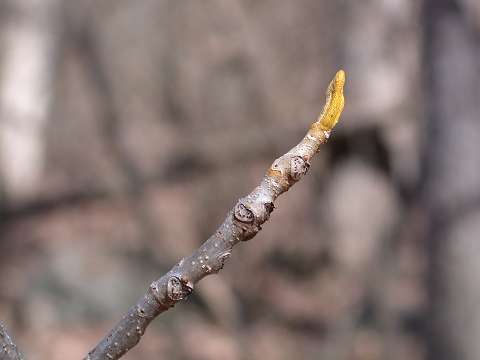

Carya cordiformis - (image 1 of 8)
Taxonomy
Family: Juglandaceae
Habitat
Woodlands, moist lowlands. Moderately tolerant of shade.
Associates
Acer saccharum, Botrychium virginianum, Carpinus caroliniana, Carya ovata, Celtis occidentalis, Claytonia virginica, Dentaria laciniata, Fraxinus americana, Geranium maculatum, Juglans nigra, Osmorhiza claytonii, Parthenocissus quinquefolia, Podophyllum peltatum, Quercus alba, Quercus rubra, Smilacina racemosa, Tilia americana, Ulmus americana, Viola pubescens. Also Euonymus obovatus, Fagus grandifolia, Lindera benzoin, and Sassafras albidum.
Distribution
Southern ME and southwest Quebec west to MN and eastern NE, south to FL and TX.
Morphology
Deciduous tree to 25 m; bark narrowly fissured in older trees but not shaggy or loosely fissured. Leaves pinnate compound, with 7-11 leaflets. Winter buds a golden yellow; terminal bud slender, the scales 4-6, valvate. Fruit husk with 4 ridges and a thin shell that splits only to the middle; kernel very bitter.
Notes
Flowers early May to mid June
Wetland indicator: Facultative Upland
The most northern of the "pecan" hickories, which have less than 6 rather valvate bud scales and fruit husks that are broadly winged at the sutures. The terminal leaflets of the pecan hickories tend not to be much larger than the laterals; total leaflets usually 7-13.
References
Farrar, J. L. 1995. Trees of the Northern United States and Canada.
Ames, Iowa: Iowa State University Press
Gleason, Henry A. and A. Cronquist. 1991. Manual of Vascular Plants of
Northeastern United States and Adjacent Canada. Second Ed.
The New York Botanical Garden. Bronx, NY
Hardin, J.W., D. J. Leopold, and F.M. White. 2000. Harlow and Harrar’s Textbook of Dendrology. Ninth Ed.
McGraw-Hill. New York.
Swink, F. and G. Wilhelm. 1994. Plants of the Chicago Region.
Indiana Academy of Science. The Morton Arboretum. Lisle, Illinois.
|
© Michael Hough 2004 |